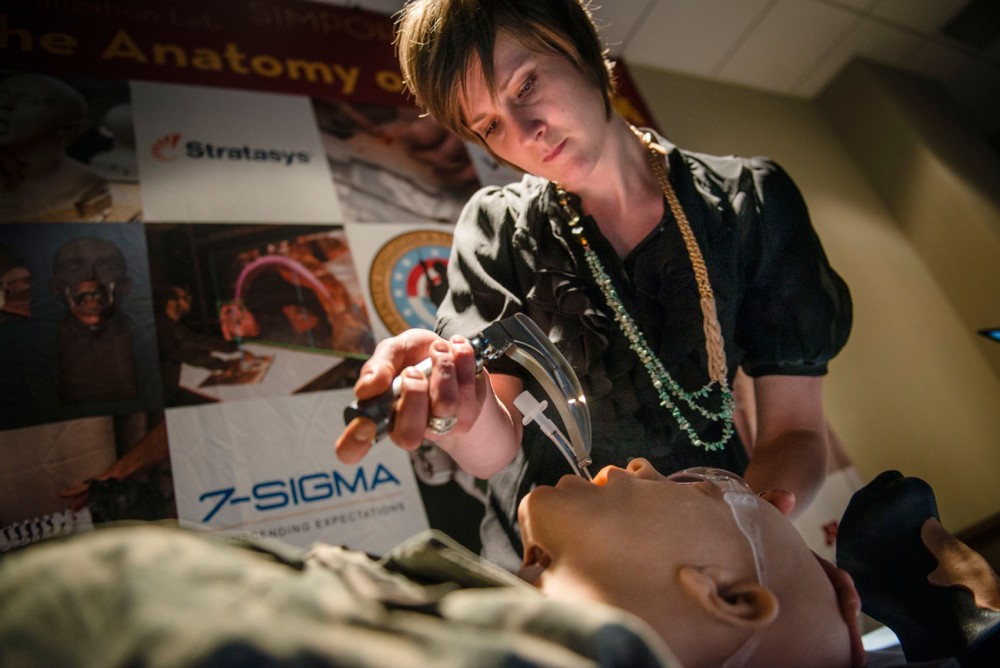Gunshots ring out as thick smoke fills the room. There’s a pile of what appears to be bodies, and their clothing is soaked with blood. A first responder has seconds to attend to the would-be victims, and the surrounding conditions will only get worse.
The simulation has begun.
The sound is recorded, a machine is bellowing smoke, and the bodies, or patient simulators, are $50,000 mannequins made of proprietary materials developed at the University of Minnesota.
The exercise and incredibly lifelike mannequins — designed for military first responders to train for a mass casualty site in the fallout of a terrorist attack — were created by University of Minnesota associate professor Pamela Andreatta and her team using millions of dollars in U.S. Department of Defense funding.
“You need to see it in person to understand,” Andreatta said. “The whole concept of it is creating a realistic environment for our first responders so they don’t have that overload and can handle the worst routinely.”
Every year, the University receives about $10 million in biomedical research grants from the department. This funding has grown in importance in recent years, said associate vice president for research Tucker LeBien, as the National Institutes of Health have reduced their contributions by nearly $5 billion since 2000.
LeBien said money from the department is “vital,” even though it’s dwarfed by the approximately $150 million in NIH funding the University receives each year.
“That’s a pretty significant difference,” LeBien said, “but on the other hand, if you eliminated DOD funding completely … then these remarkable projects would cease to exist.”
University contracts with the Department of Defense for biomedical research date back to 1993. Projects include University associate urology professor Rob Sweet’s Combat Casualty Training Consortium, with its goal of developing the best model for tactical field care by simulating injuries and medical problems experienced on the battlefield.
Sweet said they’re exploring the difference between live animal models and simulators in the attempt to replace the use of live tissue.
The Department of Defense has tremendous interest in Sweet’s project, LeBien said, because it will innovate a process that’s been used for hundreds of years and is far more cost-effective than traditional medical resources.
“He couldn’t get that type of grant support from the NIH,” LeBien said. “In an area this specific, the DOD is more of a tailored partner for this type of opportunity.”
University researchers also develop non-medical technology for the Department of Defense. Altogether, the University has about $60.5 million in military research contracts.
LeBien said the department, along with the NIH and the National Science Foundation, is among the top three sources of support for medical research and makes some of the most significant projects possible.
Andreatta said the department asked her and Sweet to develop the next generation of training systems for clinical care, with a focus on emergency medicine and trauma management.
“Historically, it’s very difficult to train clinicians for those types of events,” she said, “especially situations with mass casualties and non-conventional weapons.”
The Department of Defense awarded Andreatta $3.4 million for the research.
Using mock scenarios, the project aims to train military first responders and Twin Cities emergency personnel to respond to a chemical weapons attack. Next week, Andreatta’s team will simulate a sarin gas attack with the Plymouth Fire Department.
Though the intensity of the simulation can make the attack feel real, the key is the mannequins, which, with pseudo-skin and a complete set of faux organs, are fully functional replicas of the human body.
“We can make them bleed,” she said.
Andreatta said the researchers want to make the mannequins as realistic as possible; they’ll use patient actors from time to time so responders also have to “manage human terror.”
Unlike real patients, the mannequins provide analytics. Andreatta and Sweet said they hope to collaborate on a new project that would add sensors to the fake organs, so they can also measure the effectiveness of a trainee’s care.
“No one has ever done this before,” Andreatta said. “It’s revolutionary work, and it’s going to change the way we do clinical education.”








